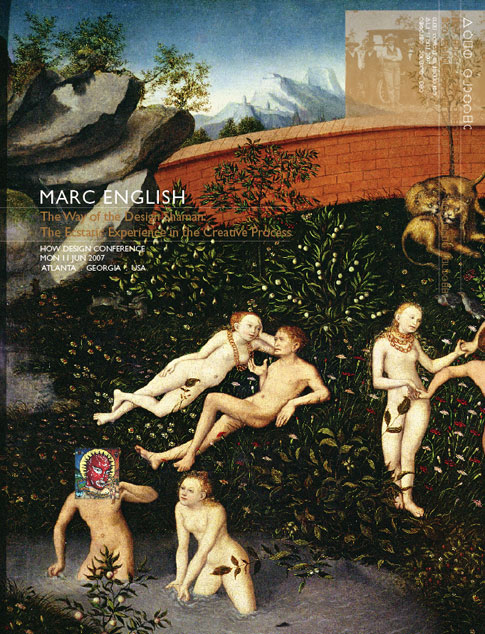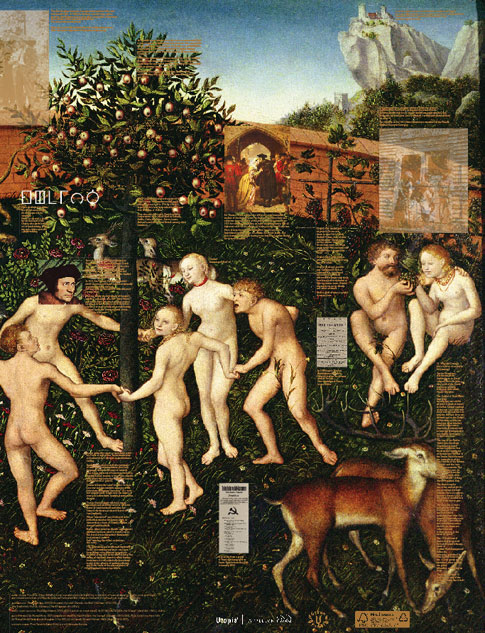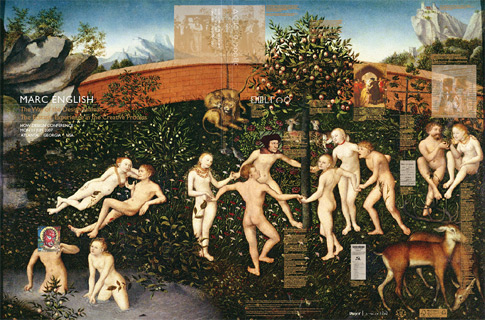
[June, 2007. Austin, Texas] About 150 miles southwest of Austin, Texas, as the crow flies, is a small town named Utopia. A gas station, post office, and a few stores make up the main street. That and the Lost Maples Cafe, which makes a damn fine pie.
The town is not named for the pies, though one could rightfully believe that.
The Rio Sabinal cuts a slow, rambling swath through the town, a ribbon of clear bluegreen thickly bordered with cypress trees as wide as cars, older than the old Spanish roads that faithfully crept up from Mexico in the 1700s, older than Comanche trails that were cut even further back.
Marc English first passed through that town in 1995, and it left more than a small mark on him, as he had needed a place to bed down, having left the Mexican border hours earlier, having left a marriage at the same time. Utopia looked as good as it could get.
Around that same time, Appleton Coated Papers, of Kimberly, Wisconsin came out with their first line of premium sheets. They named it Utopia. It wasn't long before English became aware of the paper.
Cut to ten years later, and the fall of 2005 and English - a graphic designer - is asked to sit on the Advisory Council of Appleton Coated. Small world, no?
For more than a decade, English has been on the road doing lectures, not so much about his work, but about what makes his work, about what makes him work. It was at the AIGA national conference in Boston (English's hometown) that he met Ferko Goldinger, VP of Marketing for Appleton. If English spoke of anything, he spoke of influences, of having borrowed from his own past, of recycling ideas, reusing them for better purpose. Hell, at least 30% of his work must have been recycled in one form or another, whether stealing from his own past, or of those who came before, not unlike how Texans "borrowed" from the Spanish who "borrowed" from the Comanche.
 What you see here is a poster. The first job ever printed on Appleton Coated's Utopia Two Extra Green Dull 80 pound cover, an FSC-approved sheet containing a minimum 30% post-consumer recovered fibre. Which means at least 30% recycled.
What you see here is a poster. The first job ever printed on Appleton Coated's Utopia Two Extra Green Dull 80 pound cover, an FSC-approved sheet containing a minimum 30% post-consumer recovered fibre. Which means at least 30% recycled.
And the poster? Anything but dull, It hypes English's talk at the recent HOW Design Conference in Atlanta, regarding his Way of the Design Shaman: The Ecstatic Experience in the Creative Process. The art is 100% recycled, relying on a vision of The Golden Age, by German painter Cranach the Elder, circa 1530, portraying a party of a dozen, frolicking au natural in a Utopian setting, along a body of water not unlike the Rio Sabinal, in harmony with nature. Other art includes an iconic portrait of English, circa 2002, by German-American painter, Sir Marc Burckhardt.
The fine print on the B-side refers to Sir Thomas More - Englishman, statesman, philosopher, writer, martyr - who penned the novel Utopia in 1515. Other fine points note the first Utopian society founded in Georgia (host to this year's HOW conference), and the ecstatic notions of dance and drink, among other erudite and informative tidbits of knowledge. Ah, the glories of detail. And speaking of detail, should one align copies of the poster, front to back, the poster doubles in size, growing from 19" x 25" to 38" x 25".
What we find here is a way to grow ideas. Whether those of Appleton Coated finding means to create a paper that proves not only sustainable in every sense of the word, and is also a great sheet on which to print, but also a vehicle to shine a light on the past and the ideals of Sir Thomas More's Utopia, as well as promote the shameless thievery and hyperbole of designer Marc English, of Austin, Texas, who can be found at marcenglishdesign.com.
Ideas, ideals, Utopia, all in plain English.

Four color process, plus match metallic copper.
 7Bar Aviation
7Bar Aviation AFS | Austin Film Society
AFS | Austin Film Society AFS | Austin Studios
AFS | Austin Studios AFS | Quentin Tarantino Film Fest
AFS | Quentin Tarantino Film Fest AFS | Slacker 2011
AFS | Slacker 2011 AFS | Texas Film Hall of Fame 09
AFS | Texas Film Hall of Fame 09 AIGA | Design Ranch
AIGA | Design Ranch AMF | Love Austin Music
AMF | Love Austin Music Acran
Acran Alereon
Alereon Alliance Abroad Group
Alliance Abroad Group Arc Reps
Arc Reps Austin Museum of Art Guild
Austin Museum of Art Guild Cambridge Friends School
Cambridge Friends School GirlStart
GirlStart H2Hos
H2Hos Internet Police Alliance
Internet Police Alliance KIRK
KIRK Kinsei
Kinsei La Sonrisa Productions | Inside The Circle
La Sonrisa Productions | Inside The Circle Lake Hills Church
Lake Hills Church MARK Skateboards
MARK Skateboards Marc English Design | Since 1993
Marc English Design | Since 1993 Mass. Association of Bank Council
Mass. Association of Bank Council Mountain Crossings at Walasi-Yi
Mountain Crossings at Walasi-Yi Rancho Pancho
Rancho Pancho Sharing Technologies
Sharing Technologies Texas Film & Cattle Co.
Texas Film & Cattle Co. Texas Motion Picture Alliance
Texas Motion Picture Alliance Texas Writers Month
Texas Writers Month Thokozani
Thokozani Trails to Growth
Trails to Growth Troublemaker Studios
Troublemaker Studios Tsogolo La Thanzi Centre
Tsogolo La Thanzi Centre UT/Austin | School of Architecture
UT/Austin | School of Architecture Unnatural Axe
Unnatural Axe Wright Legal
Wright Legal ABC-TV | Healthy Start / Healthy Babies
ABC-TV | Healthy Start / Healthy Babies ACADIA: Suicide, Sex & Success
ACADIA: Suicide, Sex & Success AFS | 20th Retrospective
AFS | 20th Retrospective AFS | Essential Cinema
AFS | Essential Cinema AIGA Atlanta
AIGA Atlanta AIGA Austin | Love | Work
AIGA Austin | Love | Work AIGA Baltimore
AIGA Baltimore AIGA Birmingham
AIGA Birmingham  AIGA Boston | Touch of Power
AIGA Boston | Touch of Power AIGA Charlotte
AIGA Charlotte  AIGA Honolulu
AIGA Honolulu AIGA Houston | Doug Sahm
AIGA Houston | Doug Sahm AIGA Iowa | Fertilizing Minds
AIGA Iowa | Fertilizing Minds AIGA Las Vegas
AIGA Las Vegas AIGA Miami
AIGA Miami AIGA Nashville
AIGA Nashville  AIGA Omaha | The Wolves of Texas
AIGA Omaha | The Wolves of Texas AIGA Philadelphia
AIGA Philadelphia AIGA Washington, D.C.
AIGA Washington, D.C.  Angels You Left
Angels You Left Art Directors Club of Tulsa
Art Directors Club of Tulsa Auburn University
Auburn University BF/VF | Laurie Anderson
BF/VF | Laurie Anderson BF/VF | MIra Nair
BF/VF | MIra Nair Green Room Pictures
Green Room Pictures HOW Design Conference 2007
HOW Design Conference 2007 La Sonrisa Productions | Inside the Circle
La Sonrisa Productions | Inside the Circle Manufacturing Dissent
Manufacturing Dissent NWAADC Perspective
NWAADC Perspective NWAADC Step No. 3: O.B.E.
NWAADC Step No. 3: O.B.E. Quinto Malo Films | One Minute to Nine
Quinto Malo Films | One Minute to Nine Ransom Center | Avant Garde Film
Ransom Center | Avant Garde Film Ransom Center | Brit Noir
Ransom Center | Brit Noir Ransom Center | Voyages
Ransom Center | Voyages Texas Film Hall of Fame
Texas Film Hall of Fame Texas Writers Month | 1997 | O. Henry
Texas Writers Month | 1997 | O. Henry Texas Writers Month | 1998 | Porter
Texas Writers Month | 1998 | Porter Texas Writers Month | 1999 | McMurtry
Texas Writers Month | 1999 | McMurtry Texas Writers Month | 2000 | McCarthy
Texas Writers Month | 2000 | McCarthy Texas Writers Month | 2001 | Kelton
Texas Writers Month | 2001 | Kelton Texas Writers Month | 2002 | Carpenter
Texas Writers Month | 2002 | Carpenter Texas Writers Month | 2003 | Dobie
Texas Writers Month | 2003 | Dobie Texas Writers Month | 2004 | Michener
Texas Writers Month | 2004 | Michener Criterion | Border Radio
Criterion | Border Radio Criterion | Dazed and Confused
Criterion | Dazed and Confused Criterion | My Own Private Idaho
Criterion | My Own Private Idaho Criterion | Naked
Criterion | Naked Criterion | Slacker
Criterion | Slacker Criterion | Two-Lane Blacktop
Criterion | Two-Lane Blacktop Criterion | Walker
Criterion | Walker Honora Jacob
Honora Jacob Internet Police Alliance
Internet Police Alliance Kinsei
Kinsei Legacy Trails
Legacy Trails MARK Skateboards | website
MARK Skateboards | website Site59
Site59 AFS | 20th Retrospective
AFS | 20th Retrospective AFS | Austin Studios brochure
AFS | Austin Studios brochure AFS | Texas Film Hall of Fame
AFS | Texas Film Hall of Fame Austin Chronicle | English: 2nd Language
Austin Chronicle | English: 2nd Language Austin Film Society | PoV
Austin Film Society | PoV Austin Museum of Art Guild
Austin Museum of Art Guild Chronicle Books | Cooking Up A Storm
Chronicle Books | Cooking Up A Storm Chronicle Books | Where Flavor Was Born
Chronicle Books | Where Flavor Was Born City of Austin | Create Austin Cultural Plan
City of Austin | Create Austin Cultural Plan Four Hands
Four Hands Houghton Mifflin | About Language
Houghton Mifflin | About Language Indigenous Art of Coahuila
Indigenous Art of Coahuila Inspirational Hollywood
Inspirational Hollywood Massachusetts College of Art | Compton
Massachusetts College of Art | Compton Meta Design
Meta Design Rockport Publishers | Designing Identity
Rockport Publishers | Designing Identity Texas Fine Art Association | Pulp Fictions
Texas Fine Art Association | Pulp Fictions Texas Fine Arts Association
Texas Fine Arts Association Texas Writers Month
Texas Writers Month The Art of Beowulf
The Art of Beowulf UT Department of Education
UT Department of Education UTSoA | Planning Forum
UTSoA | Planning Forum Vtel
Vtel Xetel Corporation
Xetel Corporation  AFS | Essential Cinema
AFS | Essential Cinema AFS | Fundraising Invitation
AFS | Fundraising Invitation AFS | Make Watch Love Film
AFS | Make Watch Love Film Arts Alliance America | Inning By Inning
Arts Alliance America | Inning By Inning Booker Music | Craig Hella Johnson
Booker Music | Craig Hella Johnson  Boston Brownies
Boston Brownies Criterion | Border Radio
Criterion | Border Radio Criterion | Dazed and Confused
Criterion | Dazed and Confused Criterion | Naked
Criterion | Naked Criterion | Slacker
Criterion | Slacker Criterion | Two-Lane Blacktop
Criterion | Two-Lane Blacktop Criterion | Walker
Criterion | Walker Dr. Dreams Juice Machine
Dr. Dreams Juice Machine LOL
LOL La Peste
La Peste MARK Skateboards | decks
MARK Skateboards | decks Merchants of Venus
Merchants of Venus The Good Seeds
The Good Seeds  The Stains
The Stains Two Mule Records
Two Mule Records Whole Foods Market | 365 Pasta | bag
Whole Foods Market | 365 Pasta | bag Whole Foods Market | 365 Pasta | box
Whole Foods Market | 365 Pasta | box Whole Foods Market | Belgian Chocolates
Whole Foods Market | Belgian Chocolates Whole Foods Market | Pasta
Whole Foods Market | Pasta Whole Foods Market | Pasta family
Whole Foods Market | Pasta family Whole Foods Market | Seasonal Specialties
Whole Foods Market | Seasonal Specialties Whole Foods Market | Truffles
Whole Foods Market | Truffles